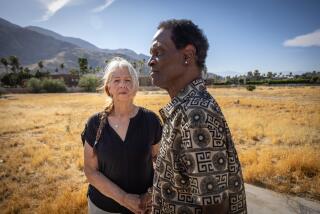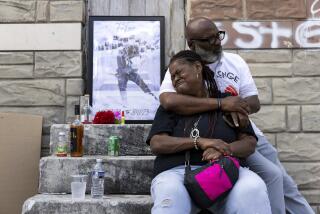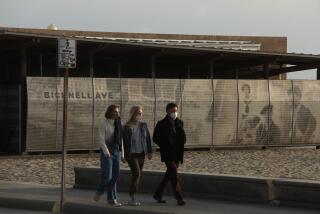Testing a City’s Limits
BENTON HARBOR, Mich. — The ancient oaks along Monroe Street are lush and green, nearly hiding the houses’ sagging porches and peeling paint. Wild lavender peeks through the cracks of the worn sidewalks and broken blacktop.
Karl Cotton grew up here. Sitting on his stoop, the 44-year-old black man sees only decay and despair; he feels nothing but pessimism and futility.
One of every six buildings in Benton Harbor is abandoned or vacant. The median household income is $17,000. About 92% of the population here is black and half the 11,200 residents don’t have a high school diploma. Unemployment hovers at 30%, but an estimated 42% of the town’s adults have stopped even looking for work.
“I was born here, raised here, and I can’t get out,” said Cotton, who lives five blocks from where a racially charged riot erupted last June. “None of us can. It’s only getting worse.”
Tod Marsh just moved in across the street from Cotton. From the vantage of his porch, the 38-year-old white man sees only possibilities and promise.
“Why wouldn’t you want to live here?” said Marsh, who opened a diner months after the riot and moved from nearby St. Joseph. “Houses are cheap, land is cheap and there are tons of opportunities.”
Last year, after a black motorcyclist was killed in a high-speed police chase, angry residents spent two nights roaming the streets, throwing bricks and setting fire to more than two dozen buildings. Ten people were arrested.
The riot has had the most unlikely effect: Very slowly, whites are moving back into town. At the same time, economic progress is coming bit by bit.
But many blacks still see the improvements as out of their reach and believe those taking advantage of the opportunities are often outsiders -- and often white. As a result, the push for gentrification has fanned old racial tensions, misunderstandings and fears.
Benton Harbor remains littered with faded reminders of its past. Nestled on the eastern shore of Lake Michigan, about 100 miles northeast of Chicago, its streets have miles of deserted homes.
Manufacturing jobs went overseas decades ago. Since then, the town’s black residents have lived with a sense of hopelessness passed down from generation to generation. Many believe they will again be left behind.
“Things are changing, but it’s happening so slow and so small that black folks just can’t see it,” said Mayor Wilce Cooke, who is black. “The changes just don’t jump out at you.”
Tod Marsh brought about one of those small changes. In the weeks after the riot, an evening drive took him down Main Street and past a small, shuttered cafe. He had been saving money, looking for a business opportunity. After peeling back the newspaper covering the windows, he found it. Marsh bought the building and last fall opened his dream restaurant, the All-American Diner. It brought 28 new jobs to town.
Other ventures also created a small number of jobs, after private investors spent millions renovating downtown buildings and financing small businesses. The potential for more jobs is real: Millions of dollars in federal and state financial aid has been designated for building low- and mixed-income homes. And developers are vying to build half-million-dollar homes along the waterfront. But construction on many of these projects is still months or years away.
The goal, say city officials, is to bring the town back to the glory days when jobs were plentiful and the harbor teemed with business.
“We’re trying to rehab an entire town,” said Jeff Noel, the president of Cornerstone Alliance, a nonprofit organization dedicated to improving the town’s economy. “Baby steps are what you’ve got to have to maintain momentum.”
After last June’s riot, Karl Cotton drove out to the edge of Benton Harbor and briefly stared at a sign that greets visitors to this “port of opportunities.”
The sign, Cotton said, is a symbol of his life. What once was a proclamation of hope and prosperity is surrounded by dozens of decrepit homes. The words themselves have worn nearly invisible from years of neglect and apathy. Faded graffiti mars its edges: “This is hell.”
Cotton’s parents, Annie and James, left Mississippi for a new start here in 1960, lured by jobs in the factories, at the ritzy hotels and in public works. Back then, Benton Harbor was a bustling middle-class town, where Chicagoans would flock to relax on the lakeshore and escape the muggy city. The town was about 75% white.
Cotton, one of seven children, remembers his mother saying, “I don’t want you to be afraid of white people. I just want you to be leery of them.”
By the early 1970s, manufacturing plants in Benton Harbor began shutting down, driven away by overseas competition. As jobs disappeared, thousands left town. James returned to Mississippi in 1973. Annie and the children stayed. She worked a variety of jobs to support her family, including housekeeping for wealthy families in St. Joseph and running a numbers game.
When the family moved to a two-story house on Monroe Street in 1975, with its gleaming dark walnut stairs and sweet-smelling backyard of wildflowers, they were the first black family on the street.
“It was hard,” said Annie Cotton, 64, who still lives in that house next door to her son. “My youngest was on the side of the house, playing in the garden, and neighbors called the police. We played the radio in the backyard ... for a birthday party, and they called the police.”
By the 1980s, most businesses had fled to St. Joseph. The local newspaper left, as did the courthouse, the hospital, most restaurants and all movie theaters. White homeowners moved across the St. Joseph River, rebuilding less than half a mile away.
Today, more than 90% of St. Joseph’s 8,700 residents are white. Unemployment is less than 4%. The median income is more than $51,000 a year.
What remained in Benton Harbor were a smattering of small enterprises and a few larger companies such as Whirlpool Corp., whose headquarters are here. Its factories, though, left long ago.
The town’s economic demise happened as Cotton came of age. When he couldn’t find a job, Cotton said, he began selling marijuana. “At a certain point, it feels like that’s all you can do,” he said. “Something illegal.”
But when Cotton’s son was born, he stopped.
“It took me two years, but I got a job doing construction,” Cotton said. “I worked nights. The blacks worked nights. The whites worked days.”
It was that underlying sense of separation that sparked the violence last June, after 27-year-old Terrance Shurn crashed to his death. It wasn’t just a lack of jobs that had people throwing bricks and setting fires, Cotton said, but also a long history of conflict with the police.
There was Arthur Partee, who died in 2003 under questionable circumstances while in police custody; Trent Patterson, a 7-year-old who died in a police chase; and Maurice Carter, who has spent nearly three decades in prison for the attempted murder of an off-duty Benton Harbor police officer -- despite mounting evidence of his innocence.
When the fires were put out, the heat of the national spotlight brought demands for change.
Some of the efforts were substantial. The Kellogg Foundation, based in Michigan, awarded the town $5 million for economic development and arts efforts. The U.S. Department of Housing and Urban Development gave $15.9 million to build low-income housing; the state agreed to provide $15.3 million to match the federal aid.
People like the Cottons saw other efforts as cosmetic: A $500,000 grant from the state created a summer jobs program.
For 10 weeks, the minimum-wage jobs -- 260 positions awarded by lottery -- employed young people 14 to 21 to mow the lawn at the local airport, handle data entry at small businesses and fill other service positions. Fewer than five people were hired permanently.
The program has returned this year. Cotton’s 17-year-old son, K.C., is applying -- but he isn’t hopeful.
“My friends make 100 times that selling drugs,” K.C. said. “I see [my father], out of work for years, willing to do anything and still not finding a job. What does that say to me? My friends? People are talking, saying maybe it’s time for the world to remember Benton Harbor again.”
After a decade in the construction business, Karl Cotton said he was forced to retire after injuring himself on the job. He drives to the local unemployment office several times a week and sifts through listings. Sometimes he gets lucky, with a stint as a newspaper carrier. But the work is often short term, he said, and he and his mother rely heavily on federal aid to pay their mortgages.
Now, Cotton dreams of getting the children away.
Though his son is only 17, Cotton thinks it’s too late. K.C. already has a felony record for resisting arrest and carrying a concealed .45 in his waistband.
Cotton’s niece, Jessica, 14, is an honors student and was first runner-up in a local beauty pageant. Jessica longs to live in a place where “everyone won’t tell us that we’re so bad all the time.” Cotton and the family are hoping to pool enough money to get away from Benton Harbor for part of the summer. They’ve already helped send Cotton’s nephew, Marvin, 18, to live in Colorado with his grandfather.
“I don’t have the money or the hope to leave,” Cotton said. “It’s not too late for them.”
Two towns away, just south along the lakeshore, Tod Marsh grew up in Stevensville, amid cornfields and dairy farms. One of seven siblings, Marsh spent much of his youth playing sports and acting in school plays.
Although few of his neighbors were black, several friends were. His father, a postal carrier in Benton Harbor for 20 years, told the children about the racial tension he saw. At the dinner table, he also spoke about the beautiful homes and lush gardens, the children selling lemonade during the summer and the parents who greeted him warmly.
“My mother always said you can’t judge someone by the way they look,” Marsh said. “She said, ‘I don’t want you to be afraid of black people.’ ”
For Marsh, the future of Benton Harbor rests less on federal dollars and more on the entrepreneurial spirit.
Since opening his diner in October, he has joined a slow, but steady, flow of entrepreneurs -- black and white -- who have set up shop downtown.
A pair of architects turned an old soda plant into their home and studio. Sculptors and other artists from Chicago and Mexico City, from Brooklyn and Benton Harbor itself transformed a state job-training center into a museum. An entrepreneur has restored the pressed-tin roof and rich brick walls of an abandoned building and now uses it as a high-end boutique.
Nearby, a Michigan winery expects to debut a tasting room and wine shop later this year, and the local newspaper plans to open a satellite office.
The city’s redevelopment groups helped Marsh get his loans and offered business advice. A lawyer in St. Joseph handled his paperwork for free, eager for the diner to succeed with its juicy burgers and luscious plates of biscuits and gravy. A garment rentals firm across the street donated hundreds of towels and napkins.
City officials acknowledge that the number of new full-time jobs trickling into Benton Harbor is so low that there’s no point in tracking them. The All-American Diner is an exception, which may be why Marsh didn’t need to take out an ad to hire his 28-person staff.
“I told two people, and we had 50 applications within two days,” he said. Today, nearly all his employees are from Benton Harbor. Most are black.
Word has spread on both sides of the river about the restaurant, and lunch draws a crowd of all ages and races.
In April, Marsh moved out of his apartment in St. Joseph and bought a four-bedroom house -- for less than $50,000 -- on Monroe Street. He and his fiance, Deborah Arnt, 44, were the third white couple on the block.
“I figured that if I was going to work in Benton Harbor, and make money in Benton Harbor, I needed to live in Benton Harbor,” Marsh said.
As the couple settles in, friends from St. Joseph and other areas have called to ask about their new hometown. When they come to visit, Marsh said, they ask about housing prices. Some are looking at houses now.
The one thing both black and white residents fear is a repeat of last June. Crammed into the city library last month, dozens of residents nervously spoke about whether the violence would happen again. The black residents sat on the left side of the room. The white residents sat on the right. Soon, the talk turned from nerves to frustration.
Cotton stood up: “Nothing is changed. None of the good you see in downtown is changing anything in the neighborhoods. The children are angry. People are angry. Can’t you see that?”
Marsh stood up: “Can’t you see how things have changed? Can’t you see the money coming in? Can’t you have faith?”
The two men stared at each other, baffled. After the meeting concluded, they walked up to each other and shook hands. And for the first time, they began to really talk.
Recently, Marsh crossed the street to Cotton’s house. The two men stood on the porch and, as the sun began to set over the lake and paint the oaks in shades of red and orange, they listened to each other.
On Friday, they went together to City Hall, to file the paperwork needed to start a community block club and watch group for Monroe Street.
More to Read
Sign up for Essential California
The most important California stories and recommendations in your inbox every morning.
You may occasionally receive promotional content from the Los Angeles Times.










